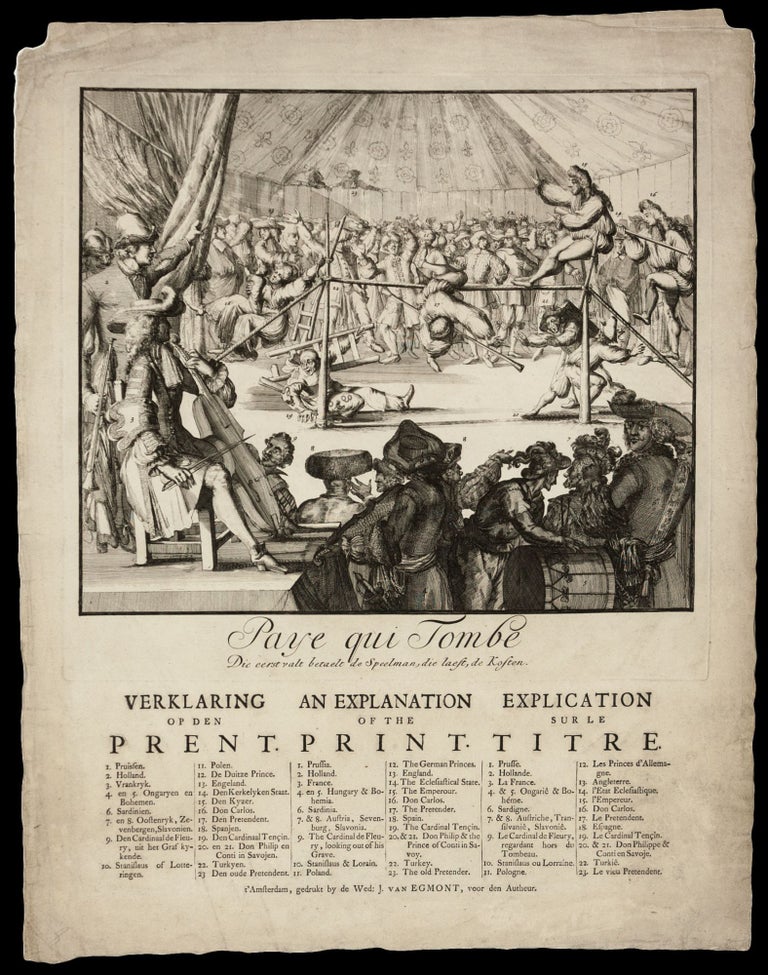
Paye qui Tombe. Die eerst valt betaelt de Speelman, die laest, de Kosten.
Separately published engraving. Large folio: [59.9 x 46.5 the sheet, 41.4 x 38.7 the platemark]. With letterpress key in Dutch, English and French below the image. Uncut on three sides, with small marginal loss on two corners along the upper margin. Generally very good. Rare satirical broadside featuring a large, finely executed engraving by the renowned Dutch printmaker Romeyn de Hooghe (1645-1708), a very unusual example of a political cartoon in which an engraved copperplate was later ‘recycled’ to fit a geopolitical situation for which it was not originally intended. De Hooghe’s Paye qui Tombe, Die eerst valt betaelt de Speelman, die laest, de Kosten (“He who falls first pays the player, he who falls last pays the costs”), which depicts a raucous troupe of comic rope-dancers at the court of France, first appeared in 1697 as a satire on the fall of James II and the Peace of Ryswick, a treaty which settled the War of the League of Augsburg (Nine Years’ War) pitting France against an alliance of England, Spain, the Holy Roman Empire, and the United Provinces (some sources date the print even earlier, to the commencement of hostilities in 1689-90). A Dutch-language poem appeared at the foot of the print glossing its meaning. In the present broadside, however, which was published some 50 years later, the engraving – printed from De Hooghe’s original, well-preserved copperplate – has been supplemented with a trilingual letterpress key that alters the names of the principal players to fit a mid-18th-century context: The print was “made to refer to the defeat of the Stuart party in England in 1746; it was probably re-published after the battle of Culloden, April 16, in 1746, had ensured the triumph of their opponents in Great Britain” (Stephens, no. 2791). “The print represents the interior of a tent or pavillion, on the roof of which are fleurs de lys and roses, emblems of France, or Louis XIV, and England, or the deposed James II. In the space within, a tight-rope is stretched. The musicians are placed in front, and a large group of spectators behind” (Stephens, no. 1337). A figure originally called ‘The First Violin Player’ (no. 3; representing William III ) in the text of the 1697 edition has here been changed to ‘France’; ‘Spain’ (no. 9) has been changed to ‘the Cardinal Fleury looking out of his grave’; a pointing spectator has been drafted to represent ‘England’ (no. 13); a tightrope walker originally called ‘Den Opperbaas’ (‘Master Player’) and representing Louis XIV had become the ‘Emperor’; the falling tightrope dancer (no. 17) has been changed from James II of England to his grandson, the ‘Young Pretender’ (Bonnie Prince Charlie); a spectator behind the fence in the distance has been relabeled as ‘The old Pretender’ (no. 23), a figure who fifty years earlier was labeled as the young child in his mother’s arms (no. 19; which in turn is here changed to ‘Spain’), and the Merry Andrew of the 1697 edition is here called ‘Cardinal Tençin’ (no. 19). A prolific printmaker, draughtsman, painter, sculptor and medalist, De Hooghe is best known for his political caricatures (principally of Louis XIV and William of Orange) and for his illustrated books, especially his work on the famed emblem book Heiroglyphica of Merkbeelden der oude volkeren. De Hooge produced over 3500 prints in his lifetime, although earlier biographers censured him for his dissolute lifestyle. OCLC locates only 1 U.S. example of this broadside (Washington University, St. Louis) and two examples of the earlier edition (Morgan Library; Washington University, St. Louis).
Price: $875.00
